英文版澳大利亚介绍
- 格式:ppt
- 大小:5.97 MB
- 文档页数:28
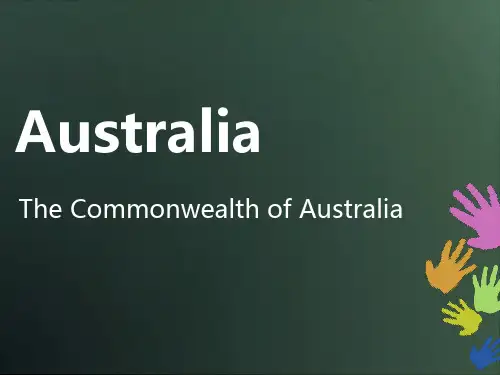
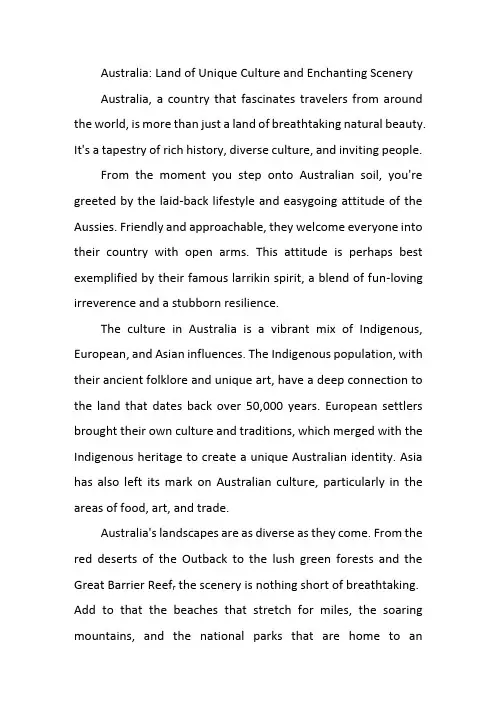
Australia: Land of Unique Culture and Enchanting SceneryAustralia, a country that fascinates travelers from around the world, is more than just a land of breathtaking natural beauty. It's a tapestry of rich history, diverse culture, and inviting people.From the moment you step onto Australian soil, you're greeted by the laid-back lifestyle and easygoing attitude of the Aussies. Friendly and approachable, they welcome everyone into their country with open arms. This attitude is perhaps best exemplified by their famous larrikin spirit, a blend of fun-loving irreverence and a stubborn resilience.The culture in Australia is a vibrant mix of Indigenous, European, and Asian influences. The Indigenous population, with their ancient folklore and unique art, have a deep connection to the land that dates back over 50,000 years. European settlers brought their own culture and traditions, which merged with the Indigenous heritage to create a unique Australian identity. Asia has also left its mark on Australian culture, particularly in the areas of food, art, and trade.Australia's landscapes are as diverse as they come. From the red deserts of the Outback to the lush green forests and the Great Barrier Reef r the scenery is nothing short of breathtaking. Add to that the beaches that stretch for miles, the soaring mountains, and the national parks that are home to anabundance of wildlife, and you have a country that is a nature lover's paradise.The cuisine in Australia is just as diverse as its people. From the iconic Australian barbecue to the rich and hearty bush tucker of the Indigenous Australians, there's something for every palate. European settlers have left their mark with dishes like Viennese coffee and Italian pizza, while Asian immigrants have introduced spicy Malaysian satays and fragrant Indian curries.Sports are an integral part of Australian culture. Australians are passionate about their sports teams, whether it's Aussie Rules Football, cricket, or horse racing. And let's not forget about the iconic Olympic Games where Australians have consistently punched above their weight, bringing home medals in a range of sports.So if you're looking for a destination that will captivate your senses with its natural beauty, rich history, and vibrant culture, then look no further than Australia. It's a country that will welcome you with open arms and make you feel right at home.。
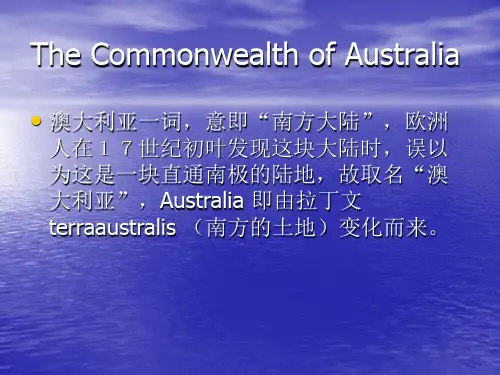
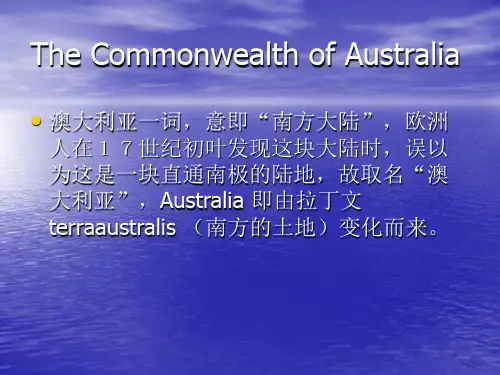
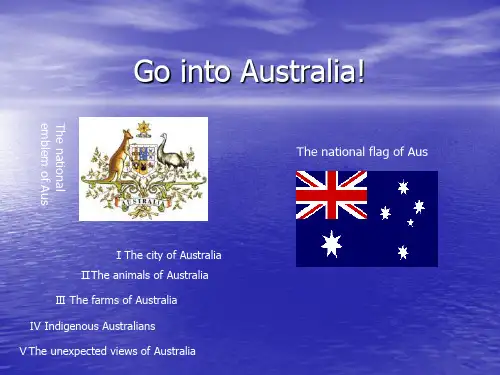
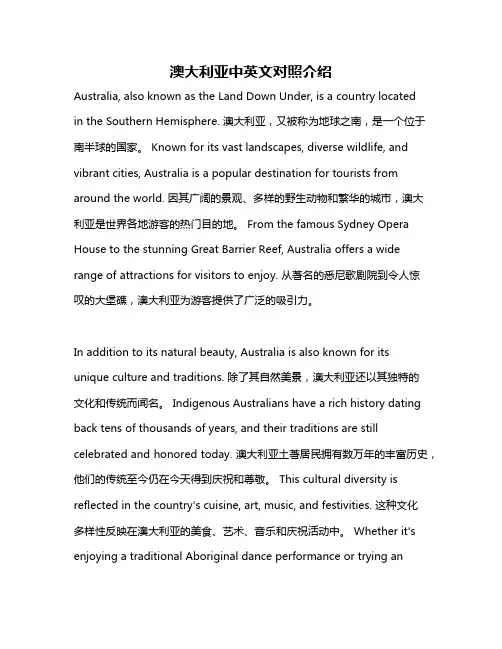
澳大利亚中英文对照介绍Australia, also known as the Land Down Under, is a country locatedin the Southern Hemisphere. 澳大利亚,又被称为地球之南,是一个位于南半球的国家。
Known for its vast landscapes, diverse wildlife, and vibrant cities, Australia is a popular destination for tourists from around the world. 因其广阔的景观、多样的野生动物和繁华的城市,澳大利亚是世界各地游客的热门目的地。
From the famous Sydney Opera House to the stunning Great Barrier Reef, Australia offers a wide range of attractions for visitors to enjoy. 从著名的悉尼歌剧院到令人惊叹的大堡礁,澳大利亚为游客提供了广泛的吸引力。
In addition to its natural beauty, Australia is also known for its unique culture and traditions. 除了其自然美景,澳大利亚还以其独特的文化和传统而闻名。
Indigenous Australians have a rich history dating back tens of thousands of years, and their traditions are still celebrated and honored today. 澳大利亚土著居民拥有数万年的丰富历史,他们的传统至今仍在今天得到庆祝和尊敬。
This cultural diversity is reflected in the country's cuisine, art, music, and festivities. 这种文化多样性反映在澳大利亚的美食、艺术、音乐和庆祝活动中。

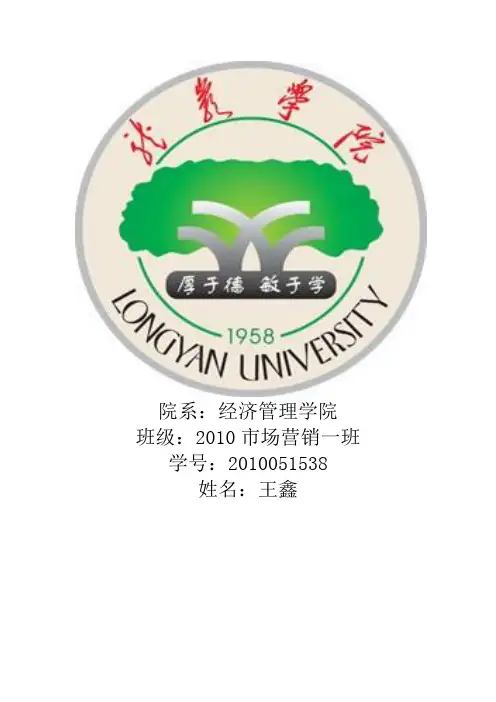
院系:经济管理学院班级:2010市场营销一班学号:2010051538姓名:王鑫Australia is a country in the southern hemisphere(南半球). It lies in most area of Oceanic. Australia is the largest country in the southern part of the Earth, the sixth largest country in the world. land area: 7,692,000 square kilometers, half larger than the whole of Western Europe. Population: 22.5 million (June 2011). The capital of Australia is Canberra. Sydney is the biggest city in the country. The official language in Australia is English.It is large country with very small population. Most of the country is covered with grassland and desert. There are a lot of wild animals living there, like kangaroos(袋鼠)and koalas(考拉). 澳大利亚是一个国家在南半球。
它坐落在最大的海洋上。
澳大利亚是世界上南半球最大的国家,是世界上国土面积第六的国家。
土地面积:7692000平方公里,比整个西欧大一半。
人口:2250万(2011年6月)。
澳大利亚的首都是堪培拉。
悉尼是全国最大的城市。
澳大利亚的官方语言是英语。
它的国土很大但人口数量却很少。
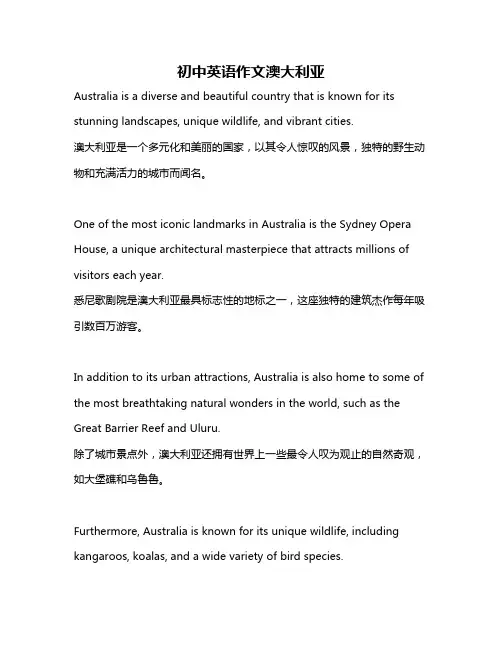
初中英语作文澳大利亚Australia is a diverse and beautiful country that is known for its stunning landscapes, unique wildlife, and vibrant cities.澳大利亚是一个多元化和美丽的国家,以其令人惊叹的风景,独特的野生动物和充满活力的城市而闻名。
One of the most iconic landmarks in Australia is the Sydney Opera House, a unique architectural masterpiece that attracts millions of visitors each year.悉尼歌剧院是澳大利亚最具标志性的地标之一,这座独特的建筑杰作每年吸引数百万游客。
In addition to its urban attractions, Australia is also home to some of the most breathtaking natural wonders in the world, such as the Great Barrier Reef and Uluru.除了城市景点外,澳大利亚还拥有世界上一些最令人叹为观止的自然奇观,如大堡礁和乌鲁鲁。
Furthermore, Australia is known for its unique wildlife, including kangaroos, koalas, and a wide variety of bird species.此外,澳大利亚以其独特的野生动物而闻名,包括袋鼠,考拉和各种各样的鸟类。
The country is also home to many indigenous Aboriginal tribes, each with its own rich culture and traditions that have been passed down for generations.这个国家还是许多土著部落的家园,每个部落都有自己丰富的文化和传统,这些传统已经传承了几代人。
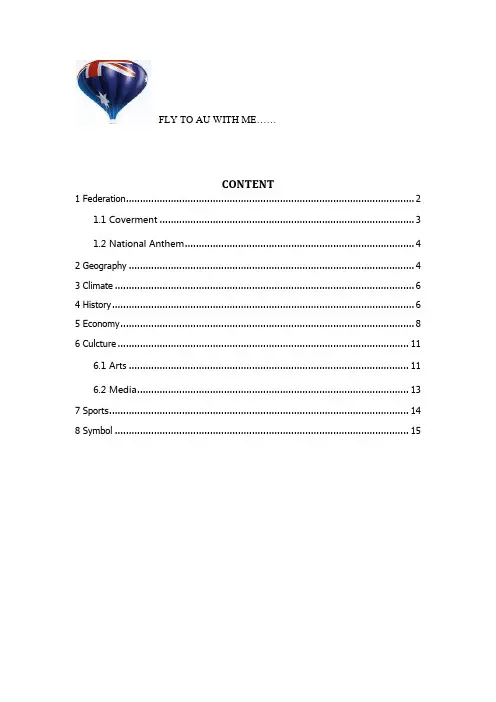
FLY TO AU WITH ME……CONTENT1 Federation (2)1.1 Coverment (3)1.2 National Anthem (4)2 Geography (4)3 Climate (6)4 History (6)5 Economy (8)6 Culcture (11)6.1 Arts (11)6.2 Media (13)7 Sports (14)8 Symbol (15)1 FederationThe Commonwealth of Australia was formed in 1901 when six independent Briti sh colonies agreed to join together and become states of a new nation.The birth of the nation is often referred to as 'federation'. This is because the Con stitution created a 'federal' system of government. Under a federal system, powers are divided between a central government and individual states. In Australia, power was d ivided between the Australian Government and the six state governments.Australia has six states: New South Wales (NSW), Queensland (QLD), South Au stralia (SA), Tasmania(TAS), Victoria (VIC) and Western Australia (WA)—and two major mainland territories—the Australian Capital Territory (ACT) and the Northern Territory (NT).1.1 CovermentAustralia is a constitutional monarchy with a federal division of powers. It uses a parliamentary system of government with Queen Elizabeth II at its apex as the Queen of Australia, a role that is distinct from her position as monarch of the other Commonwealth realms. The Queen resides in the United Kingdom, and she is represented by her viceroys in Australia (the Governor-General at the federal level and by the Governors at the state level), who by convention act on the advice of her ministers. Supreme executive authority is vested by the Constitution of Australia in the sovereign, but the power to exercise it is conferred by the Constitution specifically on the Governor-General. The most notable exercise to date of the Governor-General's reserve powers outside the Prime Minister's request was the dismissal of the Whitlam Government in the constitutional crisis of 1975.The federal government is separated into three branches:•The legislature: the bicameral Parliament, defined in section 1 of theconstitution as comprising the Queen (represented by the Governor-General),the Senate, and the House of Representatives;•The executive: the Federal Executive Council, in practice the Governor-General as advised by the Prime Minister and Ministers of State;•The judiciary: the High Court of Australia and other federal courts, whosejudges are appointed by the Governor-General on advice of the Council.Parliament House, Canberra1.2 National Anthem‘Advance Australia Fair’ is the national anthem of Australia. A revised version of a late nineteenth century patriotic song, it was officially declared the national anthem on 19 April 1984.Peter Dodds McComickAustralians all let us rejoice,For we are young and free;We've golden soil and wealth for toil,Our home is girt by sea;Our land abounds in nature's giftsOf beauty rich and rare;In history's page, let every stageAdvance Australia Fair.In joyful strains then let us sing,Advance Australia Fair.Beneath our radiant Southern Cross,We'll toil with hearts and hands;To make this Commonwealth of oursRenowned of all the lands;For those who've come across the seasWe've boundless plains to share;With courage let us all combineTo Advance Australia Fair.In joyful strains then let us sing,Advance Australia Fair.2 GeographyAustralia is a country comprising the mainland of the Australian continent, the is land of Tasmania, and numerous smaller islands. Neighbouring countries include Indo nesia, East Timor and Papua New Guinea to the north; the Solomon Islands and Vanu atu to the north-east; and New Zealand to the south-east.Australia's landmass of 7,617,930 square kilometres (2,941,300 sq mi) is on the I ndo-Australian Plate. Surrounded by the Indian and Pacific oceans, it is separated fro m Asia by the Arafura and Timor seas, and the Tasman Sea lying between Australia a nd New Zealand.The world's smallest continent and sixth largest country by total area. Australia --owing to its size and isolation—is often dubbed the "island continent", and is sometim es considered the world's largest island.Australia has 34,218 kilometres (21,262 mi) of coastline (excluding all off shore islands), and claims an extensive Exclusive Economic Zone of 8,148,250 square kilo metres (3,146,060 sq mi). This exclusive economic zone does not include the Australi an Antarctic Territory. Excluding Macquarie Island, Australia lies between latitudes 9° and 44°S, and longitudes 112°and 154°E.The Great Barrier Reef, the world's largest coral reef, lies a short distance off the north-east coast and extends for over 2,000 kilometres (1,240 mi). Mount Augustus, claimed to be the world's largest monolith, is located in Western Australia. At 2,228 metres (7,310 ft), Mount Kosciuszko on the Great Dividing Range is the highest mou ntain on the Australian mainland.Australia's size gives it a wide variety of landscapes, with tropical rainforests in the north-east, mountain ranges in the south-east, south-west and east, and dry desert in the centre.It is the flattest continent, with the oldest and least fertile soils;desert or semi-ari d land commonly known as the outback makes up by far the largest portion of land. The driest inhabited continent, only its south-east and south-west corners have a temp erate climate. The population density, 2.8 inhabitants per square kilometre, is amongthe lowest in the world, although a large proportion of the population lives along the temperate south-eastern coastline.3 ClimateThe climate of Australia is significantly influenced by ocean currents, including the Indian Ocean Dipole and the El Niño–Southern Oscillation, which is correlated with periodic drought, and the seasonal tropical low-pressure system that produces cy clones in northern Australia.These factors cause rainfall to vary markedly from year to year. Much of the northern part of the country has a tropical, predominantly summe r-rainfall (monsoon) climate. Thesouthwest corner of the country has a Mediterranean climate. Much of the southeast (including Tasmania) is temperate.4 HistoryHuman habitation of the Australian continent is estimated to have begun between 42,000 and 48,000 years ago, possibly with the migration of people by land bridges and short sea-crossings from what is nowSouth-East Asia.The first recorded European sighting of the Australian mainland, and the first recorded European landfall on the Australian continent, are attributed to the Dutch navigator Willem Janszoon. He sighted the coast of Cape York Peninsula in early 1606, and made landfall on 26 February at the Pennefather River near the moderntown of Weipa on Cape York. The Dutch charted the whole of the western and northern coastlines and named the island continent "New Holland" during the 17th century, but made no attempt at settlement.William Dampier, an English explorer and privateer, landed on the north-west coast of New Holland in 1688 and again in 1699 on a return trip. In 1770, James Cook sailed along and mapped the east coast, which he named New South Wales and claimed for Great Britain. With the loss of its American colonies in 1780, the British Government sent a fleet of ships, the "First Fleet", under the command of Captain Arthur Phillip, to establish a new penal colony in New South Wales. A camp was set up and the flag raised at Sydney Cove,Port Jackson, on 26 January 1788, a date which became Australia's national day, Australia Day although the British Crown Colony of New South Wales was not formally promulgated until 7 February 1788. The first settlement led to the foundation of Sydney, the establishment of farming, industry and commerce; and the exploration and settlement of other regions.A British settlement was established in Van Diemen's Land, now known as Tasm ania, in 1803 and it became a separate colony in 1825. The United Kingdom formally claimed the western part of Western Australia (theSwan River Colony) in 1828. Separ ate colonies were carved from parts of New South Wales: South Australia in 1836, Vi ctoria in 1851, and Queensland in 1859. The Northern Territory was founded in 1911 when it was excised from South Australia.A gold rush began in Australia in the early 1850s and the Eureka Rebellion again st mining licence fees in 1854 was an early expression of civil disobedience. Between 1855 and 1890, the six colonies individually gained responsible government, managin g most of their own affairs while remaining part of the British Empire. The Colonial Office in London retained control of some matters, notably foreign affairs,defence, an d international shipping.On 1 January 1901, federation of the colonies was achieved after a decade of pla nning, consultation and voting. The Commonwealth of Australia was established and it became a dominion of the British Empire in 1907. The Federal Capital Territory (later renamed the Australian Capital Territory) was formed in 1911 as the location for the future federal capital of Canberra. Melbourne was the temporary seat of governme nt from 1901 to 1927 while Canberra was being constructed. The Northern Territory was transferred from the control of the South Australian government to the federal par liament in 1911. In 1914, Australia joined Britain in fighting World War I, with suppo rt from both the outgoing Commonwealth Liberal Party and the incoming Australian Labor Party. Australians took part in many of the major battles fought on the Western Front.Of about 416,000 who served, about 60,000 were killed and another 152,000 were wounded. Many Australians regard the defeat of the Australian and New Zealan d Army Corps (ANZACs) atGallipoli as the birth of the nation—its first major militar y action. The Kokoda Track campaign is regarded by many as an analogous nation-de fining event during World War II.Britain's Statute of Westminster 1931 formally ended most of the constitutional links between Australia and the UK. Australia adopted it in 1942, but it was backdate d to 1939 to confirm the validity of legislation passed by the Australian Parliament du ring World War II. The shock of the United Kingdom's defeat in Asia in 1942 and thet hreat of Japanese invasion caused Australia to turn to the United States as a new ally and protector. Since 1951, Australia has been a formal military ally of the US, under the ANZUS treaty. After World War II Australia encouraged immigration from Europ e. Since the 1970s and following the abolition of the White Australia policy, immigrat ion from Asia and elsewhere was also promoted. As a result, Australia's demography, culture, and self-image were transformed. The final constitutional ties between Austr alia and the UK were severed with the passing of the Australia Act 1986, ending any British role in the government of the Australian States, and closing the option of judic ial appeals to the Privy Council in London. In a 1999 referendum, 55% of voters and a majority in every state rejected a proposal to become a republic with a president ap pointed by a two-thirds vote in both Houses of the Australian Parliament. Since the el ection of the Whitlam Government in 1972, there has been an increasing focus in fore ign policy on ties with other Pacific Rim nations, while maintaining close ties with Au stralia's traditional allies and trading partners5 EconomyAustralia is a wealthy country; it generates its income from various sources inclu ding mining-related exports, telecommunications, banking and manufacturing. It has a market economy, a relatively high GDP per capita, and a relatively low rate of pover ty.The Australian dollar is the currency for the nation, including Christmas Island, Cocos (Keeling) Islands, and Norfolk Island, as well as the independent Pacific Island states of Kiribati, Nauru, and Tuvalu. With the 2006 merger of the Australian Stock E xchange and the Sydney Futures Exchange, the Australian Securities Exchange becam e the ninth largest in the world.Ranked third in the Index of Economic Freedom (2010), Australia is the world's t welfth largest economy and has thefifth highest per capita GDP (nominal) at $66,984. The country was ranked second in the United Nations 2011 Human Development Inde x and first in Legatum's 2008 Prosperity Index. All of Australia's major cities fare wel l in global comparative livability surveys;Melbourne reached first place on The Econ omist's 2011, 2012 and 2013 world's most liveable cities lists, followed by Adelaide, Sydney, and Perth in the fifth, seventh, and ninth places respectively. Total governme nt debt in Australia is about $190 billion – 20% of GDP in 2010.Australia has among the highest house prices and some of the highest household-debt levels in the world.Over the past decade, inflation has typically been 2–3% and the base interest rate 5–6%. The service sector of the economy, including tourism, education, and financial services, accounts for about 70% of GDP. Rich in natural resources, Australia is a ma jor exporter of agricultural products, particularly wheat and wool, minerals such as iro n-ore and gold, and energy in the forms of liquified natural gas and coal. Although agr iculture and natural resources account for only 3% and 5% of GDP respectively, they contribute substantially to export performance. Australia's largest export markets are J apan, China, the US, South Korea, and New Zealand. Australia is the world's fourth la rgest exporter of wine, and the wine industry contributes $5.5 billion per year to the n ation's economy.CBD of Sydeny: one of important bussiness centers ofSouthern hemisphereAustralia major cities and ports: cities—Canberra, Sydeny, Melbourne, Perth, Brisbane, Adellaide. ports—Sydeny(biggest in AU), Melbourne, Adellaide, Belly Bay, Fremantle, Newcastle, Townsville, Perth.6、AU·DemographicsFor almost two centuries the majority of settlers, and later immigrants, came from the British Isles. As a result the people of Australia are primarily of BritishThe 2011 Census asked respondents to provide a maximum of two ancestries wit h which they most closely identify. The most commonly nominated ancestry was Eng lish(36.1%), followed by Australian (35.4%),Irish(10.4%),Scottish(8.9%), Italian(4.6%),German(4.5%),Chinese(4.3%),Indian(2.0%),Greek(1.9%), and Dutch(1. 7%). Because Australia's census doesn't ask for racial background, it is unclear how m any Australians are descendants of Europeans. Estimates vary from 85% - 92%. Asia n Australians make up 12% of the population.In 2011, 24.6% of Australians were born elsewhere and 43.1% of people had at least one overseas-born parent; the largest immigrant groups were those from the UK, New Zealand, China, India, Italy, Vietnam, and Philippines.Over 80 percent of Australia's population is of European ancestry, and most of th e rest are of Asian heritage, with a smaller minority of Indigenous background. Follo wing the abolition of the White Australia policy in 1973, numerous government initiat ives have been established to encourage and promote racial harmony based on a polic y of multiculturalism. In 2005–06, more than 131,000 people emigrated to Australia, mainly from Asia and Oceania.The migration target for 2012–13 is 190,000, compare d to 67,900 in 1998–99.6 CulctureSince 1788, the basis of Australian culture has been strongly influencedby Anglo-Celtic Western culture. Distinctive cultural features have also arisen from Australia's natural environment and Indigenous cultures. Since the mid-20th century,American popular culture has strongly influenced Australia, particularly through television and cinema. Other cultural influences come from neighbouring Asian countries, and through large-scale immigration from non-English-speaking nations.6.1 ArtsAustralian visual arts are thought to have begun with the cave paintings,rock en gravings and body painting of its Indigenous peoples. The traditions of Indigenous Australians are largely transmitted orally, through ceremony and the telling of Dreamt ime stories.From the time of European settlement, a major theme in Australian art has been the natural landscape,seen for example in the works of Arthur Streeton,To m Roberts and others associated with the Heidelberg School,and Albert Namatjira.The country's landscape remains a source of inspiration for Australian modernist artists; it has been depicted in acclaimed works by the likes of Sidney Nolan, Arthur Boyd, Fred Williams, Margaret Preston and Clifton Pugh. Australian artists influence d by modern American and European art include surrealist James Gleeson andpop arti st Martin Sharp. Contemporary Indigenous Australian art is the only art movement of international significance to emerge from Australia and "the last great art movement of the 20th century"; its exponents have included Emily Kngwarreye. Art critic Rober t Hughes has written several influential books about Australian history and art, and was described as the "world's most famous art critic" by The New York Times. The N ational Gallery of Australia and state galleries maintain Australian and overseas collec tions. Australia has one of the world's highest attendances of art galleries and museum s per head of population—far more than Britain or AmericaMany of Australia's performing arts companies receive funding through the feder al government's Australia Council. There is a symphony orchestra in each state, and a national opera company, Opera Australia, well-known for its famous soprano Joan Su therland. At the beginning of the 20th century, Nellie Melba was one of the world's leading opera singers.] Ballet and dance are represented by The Australian Ballet and various state companies. Each state has a publicly funded theatre company.Australian literature has also been influenced by the landscape; the works of writ ers such as Banjo Paterson, Henry Lawson, and Dorothea Mackellar captured the expe rience of the Australian bush. The character of the nation's colonial past, as represente d in early literature, is popular with modern Australians. In 1973, Patrick White was awarded the Nobel Prize in Literature, the first Australian to have achieved this. Austr alian winners of the Man Booker Prize have included Peter Carey and Thomas Keneal ly; David Williamson, David Malouf, and J. M. Coetzee, who recently became an Aus tralian citizen, are also renowned writers, and Les Murray is regarded as "one of the leading poets of his generation"6.2 MediaThe Australian cinema industry began with the 1906 release of The Story of the Kelly Gang, which is regarded as being the world's first feature-length film; but both Australian feature film production and the distribution of British-made features declin ed dramatically after World War I as American studios and distributors monopolised the industry, and by the 1930s around 95% of the feature films screened in Australia were produced in Hollywood. By the late 1950s feature film production in Australia had effectively ceased and there were no all-Australian feature films made in the deca de between 1959 and 1969.Thanks to initiatives by the Gorton and Whitlam federal governments, the New Wave of Australian cinema of the 1970s brought provocative and successful films, so me exploring the nation's colonial past, such as Picnic at Hanging Rock and Breaker Morant, while the so-called "Ocker" genre produced several highly successful urban-based comedy features including The Adventures of Barry McKenzie and Alvin Purpl e. Later hits included Mad Max and Gallipoli. More recent successes included Shine and Rabbit-Proof Fence. Notable Australian actors include Judith Anderson, Errol Fly nn, Nicole Kidman, Naomi Watts, Hugh Jackman, Heath Ledger, Geoffrey Rush, an d Cate Blanchett—current joint director of the Sydney Theatre Company.Australia has two public broadcasters (the Australian Broadcasting Corporation and the multicultural Special Broadcasting Service), three commercial television netw orks, several pay-TV services, and numerous public, non-profit television and radio stations. Each major city has at least one daily newspaper, and there are two national daily newspapers, The Australian and The Australian Financial Review. In 2010, Rep orters Without Borders placed Australia 18th on a list of 178 countries ranked by press freedom, behind New Zealand (8th) but ahead of the United Kingdom (19th) and Un ited States (20th). This relatively low ranking is primarily because of the limited diversity of commercial media ownership in Australia; most print media are under the control of News Corporation and Fairfax Media7 SportsAbout 24% of Australians over the age of 15 regularly participate in organised sporting activities. Australia has strong international teams in cricket, field hockey, netball, rugby league, and rugby union, having been Olympic or world champions at least twice in each sport in the last 25 years for both men and women where applicabl e. Australia is also powerful in track cycling, rowing, and swimming, having consiste ntly been in the top-five medal-winners at Olympic or World Championship level sinc e 2000.Swimming is the strongest of these sports; Australia is the second-most prolifi c medal winner in the sport in Olympic history.Some of Australia's most internationally well-known and successful sports peopl e are swimmers Dawn Fraser, Murray Rose,Shane Gould, and Ian Thorpe; sprinters Shirley Strickland, Betty Cuthbert, and Cathy Freeman; tennis players Rod Laver, Ro y Emerson, Ken Rosewall, Evonne Goolagong, and Margaret Court; cricketers Donal d Bradman and Shane Warne; three-time Formula One world champion Jack Brabha m; five-time motorcycle grand prix world champion Mick Doohan; golfers Greg Norman and Karrie Webb;cyclist Hubert Opperman, prodigious billiards player Walte r Lindrum and basketball players Andrew Bogut and Lauren Jackson. Nationally, other popular sports include Australian rules football, horse racing, squash, surfing, soccer, and motor racing. The annual Melbourne Cup horse race and theSydney to Hobart yacht race attract intense interest.Australia has participated in every summer Olympics of the modern era, and every Commonwealth Games. Australia hosted the 1956 Summer Olympics in Melbo urne and the 2000 Summer Olympics in Sydney, and ranked among the top six medal-takers for the games of 2000, 2004 and 2008. In the 2012 Summer Olympics in Londo n, Australia was placed 10th in the medal table. Australia has also hosted the 1938, 1962, 1982, 2006 Commonwealth Games and will host the 2018 Commonwealth Games. Other major international events held in Australia include the Australian Open tennis grand slam tournament, international cricket matches, and the Australian Formula One Grand Prix. Australia hosted the 2003 Rugby World Cup and the annual Australia–New ZealandBledisloe Cup is keenly watched. The highest-rating televisio n programs include sports telecasts such as the summer Olympics, FIFA World Cup, Rugby League State of Origin, and the grand finals of the National Rugby League and Australian Football League. Skiing in Australia began in the 1860s and snow spor ts take place in the Australian Alps and parts of Tasmania.8 SymbolThe flag of Australia is a defaced Blue Ensign: a blue field with the Union Jack in the canton (upper hoist quarter), and a large white seven-pointed star known asthe Commonwealth Star in the lower hoist quarter. The fly contains a representation of the Southern Cross constellation, made up of five white stars – one small five-pointed star and four, larger, seven-pointed stars.The coat of arms of Australia (officially known as the Commonwealth Coat of Arms) is the official symbol ofAustralia. The initial coat of arms was granted by King Edward VII on 7 May 1908, and the current version was granted by King GeorgeV on 19 September 1912, although the 1908 version continued to be used in some contexts, notably appearing on the sixpenny coin until 1966.The kangaroo is a marsupial from the family Macropodidae.The emu is the largest bird native toAustralia and the only extant member of the genus Dromaius.The koala is an arboreal herbivorous marsupial native toAustralia. It is theonly extant representative of the family Phascolarctidae, and its closest living relatives are the wombats.The Great Barrier Reef is the world's largest coral reef system composed of over 2,900 individual reefs and 900 islands stretching for over 2,300 kilometres (1,400 mi) over an area of approximately 344,400 square kilometres (133,000 sq mi). The reef is located in the Coral Sea, off the coast of Queensland,Australia.Lake Eyre is the lowest natural point inAustralia, at approximately 15 m (49 ft) below sea level (AHD), and, on the rare occasions that it fills, the largest lake in Australia and 18t largest in the world.The Great Victoria Desert, an interim Australian bioregion, is a sparsely populated desert area in Western Australia and South Australia.THE WORLD MAKES WAY FOR THE MAN WHO KNOWS WHERE HE IS GOING!。
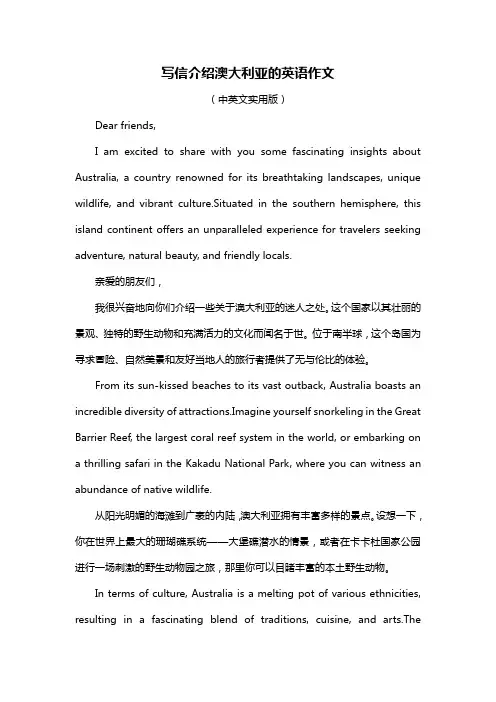
写信介绍澳大利亚的英语作文(中英文实用版)Dear friends,I am excited to share with you some fascinating insights about Australia, a country renowned for its breathtaking landscapes, unique wildlife, and vibrant culture.Situated in the southern hemisphere, this island continent offers an unparalleled experience for travelers seeking adventure, natural beauty, and friendly locals.亲爱的朋友们,我很兴奋地向你们介绍一些关于澳大利亚的迷人之处。
这个国家以其壮丽的景观、独特的野生动物和充满活力的文化而闻名于世。
位于南半球,这个岛国为寻求冒险、自然美景和友好当地人的旅行者提供了无与伦比的体验。
From its sun-kissed beaches to its vast outback, Australia boasts an incredible diversity of attractions.Imagine yourself snorkeling in the Great Barrier Reef, the largest coral reef system in the world, or embarking on a thrilling safari in the Kakadu National Park, where you can witness an abundance of native wildlife.从阳光明媚的海滩到广袤的内陆,澳大利亚拥有丰富多样的景点。
关于澳大利亚的手抄报英文版AustraliaAustralia, formally known as the Commonwealth of Australia, is a country located in the southern hemisphere. It is the world's sixth-largest country by total area. Australia is famous for its stunning natural beauty, diverse wildlife, and vibrant cities.Geography: Australia is situated between the Indian and Pacific Oceans. It is surrounded by several smaller islands, including Tasmania and the Great Barrier Reef. The country is known for its varied landscapes, ranging from vast deserts, rugged mountains, tropical rainforests, and iconic beaches.Wildlife: Australia is home to some of the most unique and diverse wildlife on the planet. The country is known for its kangaroos, koalas, wombats, and the infamous Tasmanian devil. It is also home to various reptiles, including the world's deadliest snake, the inland taipan.Culture: The Australian culture is a fusion of indigenous Aboriginal traditions and influences from various immigrant settlers. The country celebrates its diversity through multicultural festivals and events. Australians are known for their laid-back and easy-going nature, often referred to as the "Aussie spirit." Tourism: Australia is a popular tourist destination, attracting millions of visitors each year. The Great Barrier Reef, located off the coast of Queensland, is one of the Seven Natural Wonders of the World and a UNESCO World Heritage Site. Other popular attractions include the Sydney Opera House, Uluru (Ayers Rock),and the iconic beaches of Bondi and Surfers Paradise.Sports: Australians are passionate about sports, with cricket, Australian rules football, rugby, and soccer being popular nationwide. The country has a strong sporting culture and has produced legendary athletes in various disciplines, including swimming, tennis, and cricket.Economy: Australia has a highly developed market economy. It is one of the world's largest exporters of agricultural products, including wheat, beef, and wool. The country is also rich in natural resources, with significant mining and extraction sectors. Additionally, Australia has a strong service-based economy, particularly in tourism and education.Overall, Australia is a captivating country with its unique wildlife, stunning landscapes, and vibrant culture. Whether you are exploring the diverse beauty of the outback or immersing yourself in the cosmopolitan cities, Australia offers a wealth of experiences for its visitors.。
澳大利亚国家介绍英文含翻译1. Geography and Environment:Australia is characterized by a vast and varied landscape, including deserts, rainforests, mountains, and pristine coastlines. The famous Outback refers to the vast, arid interior, while the Great Barrier Reef, the world's largest coral reef system, lies off the northeastern coast.澳大利亚以其广阔而多样的地形而闻名,包括沙漠、热带雨林、山脉和原始海岸线。
著名的内陆指的是广阔而干旱的内陆地区,而大堡礁,世界上最大的珊瑚礁系统,位于东北海岸。
2. Wildlife:Australia is home to a unique array of wildlife, including iconic marsupials such as kangaroos and koalas. The country is also known for its diverse bird species and reptiles, many of which are found nowhere else in the world.澳大利亚拥有独特的野生动物,包括标志性的有袋动物,如袋鼠和考拉。
该国还以其多样的鸟类和爬行动物而闻名,其中许多仅在这个世界上的这一片土地上找得到。
3. Culture:Australia has a rich cultural heritage that reflects its Indigenous roots and the influence of immigrants from various parts of the world. The Aboriginal and Torres Strait Islander peoples have a deep connection to the land, and their art, music, and storytelling traditions are integral to the nation's identity.澳大利亚拥有丰富的文化遗产,反映了其土著根源以及来自世界各地的移民的影响。
澳大利亚旅游介绍英文Australia is a country and continent located in the Southern Hemisphere, known for its diverse landscapes, vibrant cities, and unique wildlife. Here is an introduction to some of the must-see destinations and experiences when visiting Australia.Sydney, the largest city in Australia, is a bustlingmetropolis that offers a mix of modern architecture andnatural beauty. The iconic Sydney Opera House, with its distinctive sail-like design, is a UNESCO World Heritage site and a symbol of the nation. Nearby, the Sydney Harbour Bridge provides breathtaking views of the city and the harbour. Visitors can also explore the Royal Botanic Garden, which is home to a wide variety of native plants and offers a peaceful retreat from the city's hustle and bustle.Melbourne, the cultural capital of Australia, is famous forits arts, music, and food scenes. The city's laneways arelined with street art, cafes, and boutique shops, making it a haven for those seeking a more intimate urban experience. The Great Ocean Road, a scenic drive that starts just outside Melbourne, offers stunning coastal views and leads to the Twelve Apostles, a collection of limestone stacks that rise majestically from the Southern Ocean.For those interested in Australia's indigenous culture, avisit to Uluru, also known as Ayers Rock, is a must. This massive sandstone monolith is sacred to the Anangu people andoffers a glimpse into the country's ancient history. The nearby Kata Tjuta, also known as the Olgas, is another significant site with its own unique geological formations.The Great Barrier Reef, the world's largest coral reef system, is a natural wonder that stretches over 2,300 kilometersalong the Queensland coast. Divers and snorkelers can explore the vibrant underwater world teeming with marine life, while those who prefer to stay dry can take a scenic flight to appreciate the reef's vastness.Tasmania, an island state to the south of the Australian mainland, is known for its rugged wilderness and pristine natural beauty. The Cradle Mountain-Lake St Clair National Park is a popular destination for hiking and wildlife spotting, while the Freycinet National Park offers stunning beaches and the chance to see the famous Wineglass Bay.Australia's wildlife is one of its most famous attractions, with the opportunity to see kangaroos, koalas, and wombats in their natural habitat. The Kangaroo Island is a haven for wildlife enthusiasts, offering close encounters with these iconic creatures.No trip to Australia would be complete without experiencingits beaches. From the surf culture of Bondi Beach in Sydneyto the tranquility of Whitehaven Beach in the Whitsunday Islands, there is a beach for every taste.Lastly, Australia's wine regions, such as the Barossa Valleyin South Australia and the Hunter Valley in New South Wales,offer visitors the chance to sample some of the country's finest wines and enjoy the picturesque vineyard landscapes.In conclusion, Australia is a country of contrasts, offering everything from bustling cities to serene natural landscapes. Whether you're a city lover, a nature enthusiast, or aculture seeker, Australia has something for everyone.。
介绍澳大利亚的英语作文六年级我们都知道澳大利亚的风景十分迷人,那么在介绍澳大利亚的时候我们应该怎么写。
以下是小编为大家整理的有关介绍澳大利亚的英语,希望大家喜欢。
介绍澳大利亚的英语作文篇一Australia is the sixth largest country in the world.The ground of Australia is two of west Europe.There is large area and lots of resource.Australia is the strongest developed country of economy in south earth.It's also the fourth export country of agriculture in the world.It is the biggest export country of iorn as well.Australia is a typical immgriation country and has varity of cultures.20 percent of Australia are birth in the other countries.Australia is a good country in pc.There are so many times opening international pc activities.介绍澳大利亚的英语作文篇二With an area of eight million square kilometres,Australia is the sixth largest country in the world.The population stands at just twenty million,of whom some 85% live in urban areas,mainly along the coast.Much of Australia is arid and flat.One-third of the country is desert and another third is steppe or semi-desert.Australia's main exports are fossil fuels,minerals,metals,cotton,wool,wine and beef,and its most important trading partners are Japan,China and the US.介绍澳大利亚的英语作文篇三Australian is a wonderful place with climate that suits everybody. It has many natural heritages, but cultural heritages are very limted. The most famous places are the Great Barrier Reef, the Sydney Harbour Bridge, the Sydney Opera House, as well as other wilderness.People in Australia are very friendly, and are very willing to help anybody in need, but there are exceptions.It is one of the few countries apart from United States of America that is multicultural, meaning that people in Australia can get things from almost any culture. From lebanese bread from the Middle East, to Tofu from Asia, to fish and chips from England. Everything combines in a very harmonic way that there is hardly any conflicts.介绍澳大利亚的英语作文篇四AustraliaAustralia,the largest country in Oceania,lies on the south coast of the Pacific.It covers an area of 7.6 million square kilometers.It has a population of over 10 million.Most of its people live in the east of the country by the sea.Canberra,the capital of Australia,is a beautiful city.Sydney is the biggest city in Australia,which has many places of interest.The Opera House is well known all over the world.The 20xx Olympic Games were held in Sydney.介绍澳大利亚的英语作文篇五Australian is a wonderful place with climate that suits everybody. It has many natural heritages, but cultural heritages are very limted. The most famous places are the Great Barrier Reef, the Sydney Harbour Bridge, the Sydney Opera House, as well as other wilderness.People in Australia are very friendly, and are very willing to help anybody in need, but there are exceptions.It is one of the few countries apart from United States of America that is multicultural, meaning that people in Australia can get things from almost any culture. From lebanese bread from the Middle East, to Tofu from Asia, to fish and chips from England. Everything combines in a very harmonic way that thereis hardly any conflicts.。